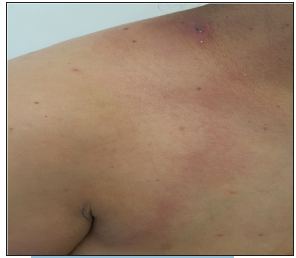Introduction
Superficial lymphangitis after insect bite is the result of an allergic reaction to the insect antigen, which is injected into the skin and drained by lymphatic vessels [1].
Clinical Case
A 22-year-old female with no notable medical history, presented with a pruritic rash on the chest. She mentioned intense pruritus and low pain. Two days before she had been bitten on the shoulder by a spider.
Physical examination showed a red linear lesion starting from erythematous macule of the shoulder and extending toward the anterior wall of the chest. Neither fever nor lymph node enlargement were present. Cardiovascular exams, Pleuropulmonary and neurologic were normal. A diagnosis of superficial lymphangitis after spider bite was made, based on the history and lesion’s characteristic. The patient was treated with oral antihistamines and topical corticosteroids for a week with good evolution.
Spiders or aramids are predators’ arthropod invertebrates of the class of arachnids, ubiquitous and their bites are common even in urban areas. The spider sting is often asymptomatic thus passing unnoticed [2].

Conclusion
Lymphangitis secondary to a spider bite constitutes one of the complications not usually encountered, the interrogation is crucial to determine the diagnosis, in the absence of general complications, evolution remains benign.
More BJSTR Articles : https://biomedres01.blogspot.com


No comments:
Post a Comment
Note: Only a member of this blog may post a comment.